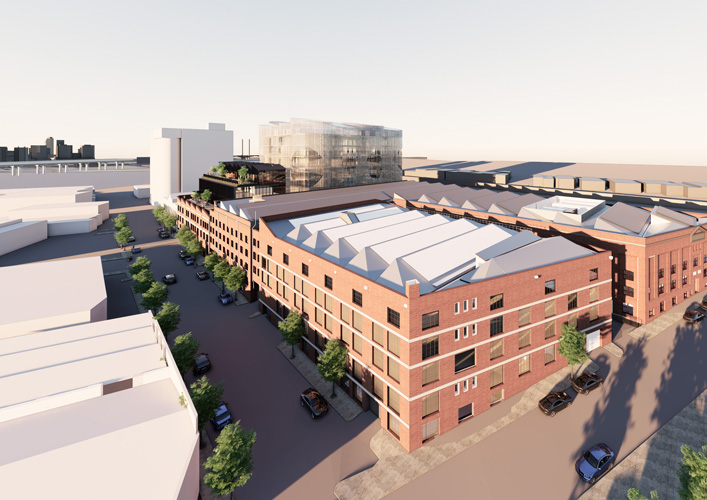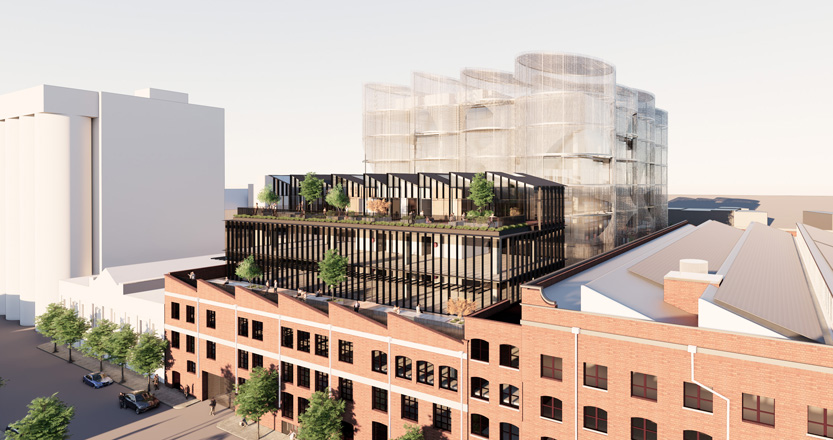Green light for towers at iconic Younghusband Woolstores
A major revamp of Kensington’s century-old former Younghusband Woolstores site has moved a step closer after the City of Melbourne ticked off plans despite them not complying with heritage policies.
As part of Impact Investment Group’s ambitious proposal to revitalise the industrial site at a cost of $87 million, the state government recently referred stage two of the plans to the council.
At their Future Melbourne Committee meeting on September 7, councillors voted unanimously in favour of the application that proposed to demolish parts of the iconic red-brick warehouses to make way for two towers more than 42 and 26 metres tall.
This was despite a council report stating the proposed demolition had not complied with the council’s heritage policy, however, it recommended councillors support the six- and eight-storey towers because overall it achieved “an acceptable outcome”.
“When the loss of this fabric is weighed against the overwhelming conservation of original fabric achieved in stage one … the overall heritage outcome for the site is considered to be highly positive, and the extent of demolition has been supported for this reason,” the report said.
The council report also noted the proposed eight-storey building exceeded the “preferred height” of the City of Melbourne’s planning scheme, but due to the “sophisticated design response achieved” in stage two, council officers supported the additional height.
Speaking at the council meeting, Deputy Lord Mayor Nicholas Reece said while the application designed by architects Woods Bagot had not “strictly” complied with council’s heritage policies, demolition “should be allowed in this case because of the considerable conservation of the Younghusband complex overall, and also because of the significant public benefits”.
To describe this complex as an iconic building is probably an understatement, it’s probably the most iconic building I would say in this part of Melbourne.
But he said the council was “viewing this complex in its entirety” and any demolition permit issued would be subject to a condition that stages one and two of the project were “very much linked” to ensure they were not “inconsistent” with the overall development.
“That’s something that’s particularly important because it should be noted that the site has been put up for sale, and we want to ensure that any future owners of stage two or of the entire complex must observe the requirements for the overall development of the site,” he said.
“That means that stage one cannot be developed in a way which is inconsistent with what’s happening with stage two and conversely, stage two cannot be developed in a way which is inconsistent with what’s been approved with stage one.”
Under the stage two application, the early-1900s built Tallow Store No. 3 would be partially demolished to make way for a six-storey building, while the 1957-built Wool Store No.5 would be completely demolished to build a new eight-storey “silo-inspired” facade building at a height of 43.9 metres.
The proposed 26.9-metre-tall building to be built at the site of the Tallow Store would feature a box design with clear glazed cladding and be recessed behind the retained Elizabeth St facade, along with part of the southern facade.
The proposed site would house offices as well as food and drink shops, and a two-level basement for parking.
Heritage portfolio lead Cr Rohan Leppert described the former Younghusband Wool and Grain Warehouses precinct as “utterly special” and while the council’s “heritage policy is probably strong enough” to refuse a demolition permit for stage two, he said the application was thorough and overall respective of the site’s heritage significance.
“If you consider all the heritage fabric across the entire precinct and just how monumentally expensive it is to maintain, we really want an owner and an applicant who is fully committed to preserving that heritage fabric, and I think we’ve got a scheme put forward here that does do that,” he said at the Future Melbourne Committee meeting.
He said it was vital a “tight arrangement” was in place for stages one and two “so that you can continue to have that masterplan precinct approach, no matter who owns individual parts of these buildings in the future”.
Cr Leppert added that the fact that few objections had been submitted was a “testament to the work” of the applicant and the members of the community who had been “very deeply engaged” in having their say on the project.
Kensington Association president Simon Harvey said following a “fairly thorough discussion” the association was concerned a precedent would be set if the plans were approved.
However, given stages one and two of the project would be linked and a further condition added to retain the pedestrian and bicycle lane near the Kensington railway station, Mr Harvey said members “feel okay about it”.
“Given those two legal conditions … I feel happy that it’s progressing,” Mr Harvey told North West City News.
While he conceded he wasn’t personally “excited” about the plans, he understood it was “the best option that can be realised at this particular point in time”.
Mr Harvey said he was still concerned about parking space which hadn’t been raised by the association’s latest meeting, but “it may well become an issue in the future”.
“It’s a great site and I just hope it works out.”
The warehouses were originally bought by wool giant Younghusband & Co in 1902 and are one among the last remaining wool stores in Victoria.
Impact Investment Group, the owner of the site, announced in July that it was ready to offload the heritage site after paying $30.25 million in 2016.
“The property is on the market and all proposals will be considered on their merits,” Impact’s head of funds management, real estate, Darren Brusnahan said.
“There may be an outright sale or a joint venture with a group that can deliver the aspirations that we have for the site, and that council supports.”
Impact has not outlined why it has put the historic site up for sale, however, Mr Brusnahan last month said, “the long-term potential for Younghusband remains strong” and is “a strategic site that is benefiting from significant investment in road and rail”.
However, any application permits attached to the land would be unaffected by any future change of ownership.
Under the proposed development, the complex would be transformed into a “beautiful industrial village” in three stages over five years. A green space, work spaces, and further office space is proposed for the development.
The approved application for stage two will be referred to the Planning Minister Richard Wynne who ultimately decides whether a permit should be granted •
Captions: An artist’s impression of a view looking north along Elizabeth St with the redevelopment at the Younghusband Woolstores site.
An artist’s impression “silo-inspired” facade at the Younghusband Woolstores site.
An artist’s impression of a view looking east from Fink St.

Jo Ryan unveils Ordered Chaos at Blender Studios







 Download the Latest Edition
Download the Latest Edition